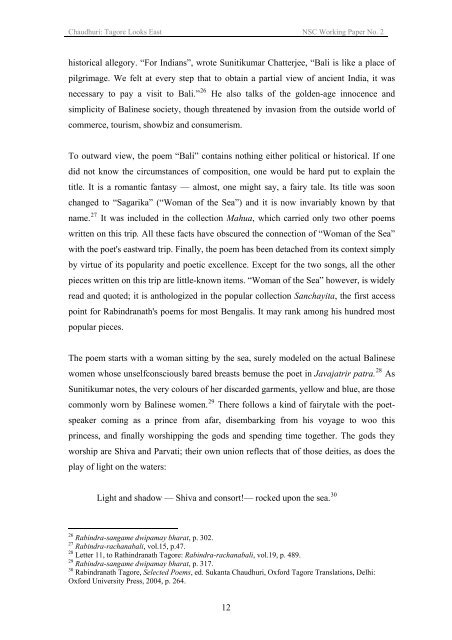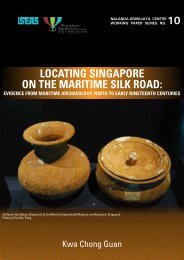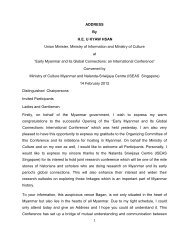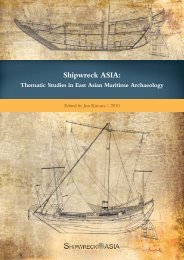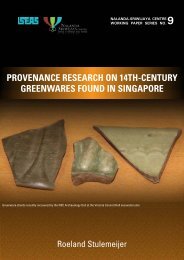2 TAGORE LOOKS EAST - Nalanda-Sriwijaya Centre - iseas
2 TAGORE LOOKS EAST - Nalanda-Sriwijaya Centre - iseas
2 TAGORE LOOKS EAST - Nalanda-Sriwijaya Centre - iseas
- No tags were found...
You also want an ePaper? Increase the reach of your titles
YUMPU automatically turns print PDFs into web optimized ePapers that Google loves.
Chaudhuri: Tagore Looks East NSC Working Paper No. 2historical allegory. “For Indians”, wrote Sunitikumar Chatterjee, “Bali is like a place ofpilgrimage. We felt at every step that to obtain a partial view of ancient India, it wasnecessary to pay a visit to Bali.” 26 He also talks of the golden-age innocence andsimplicity of Balinese society, though threatened by invasion from the outside world ofcommerce, tourism, showbiz and consumerism.To outward view, the poem “Bali” contains nothing either political or historical. If onedid not know the circumstances of composition, one would be hard put to explain thetitle. It is a romantic fantasy — almost, one might say, a fairy tale. Its title was soonchanged to “Sagarika” (“Woman of the Sea”) and it is now invariably known by thatname. 27 It was included in the collection Mahua, which carried only two other poemswritten on this trip. All these facts have obscured the connection of “Woman of the Sea”with the poet's eastward trip. Finally, the poem has been detached from its context simplyby virtue of its popularity and poetic excellence. Except for the two songs, all the otherpieces written on this trip are little-known items. “Woman of the Sea” however, is widelyread and quoted; it is anthologized in the popular collection Sanchayita, the first accesspoint for Rabindranath's poems for most Bengalis. It may rank among his hundred mostpopular pieces.The poem starts with a woman sitting by the sea, surely modeled on the actual Balinesewomen whose unselfconsciously bared breasts bemuse the poet in Javajatrir patra. 28 AsSunitikumar notes, the very colours of her discarded garments, yellow and blue, are thosecommonly worn by Balinese women. 29 There follows a kind of fairytale with the poetspeakercoming as a prince from afar, disembarking from his voyage to woo thisprincess, and finally worshipping the gods and spending time together. The gods theyworship are Shiva and Parvati; their own union reflects that of those deities, as does theplay of light on the waters:Light and shadow — Shiva and consort!— rocked upon the sea. 3026 Rabindra-sangame dwipamay bharat, p. 302.27 Rabindra-rachanabali, vol.15, p.47.28 Letter 11, to Rathindranath Tagore: Rabindra-rachanabali, vol.19, p. 489.29 Rabindra-sangame dwipamay bharat, p. 317.30 Rabindranath Tagore, Selected Poems, ed. Sukanta Chaudhuri, Oxford Tagore Translations, Delhi:Oxford University Press, 2004, p. 264.12


